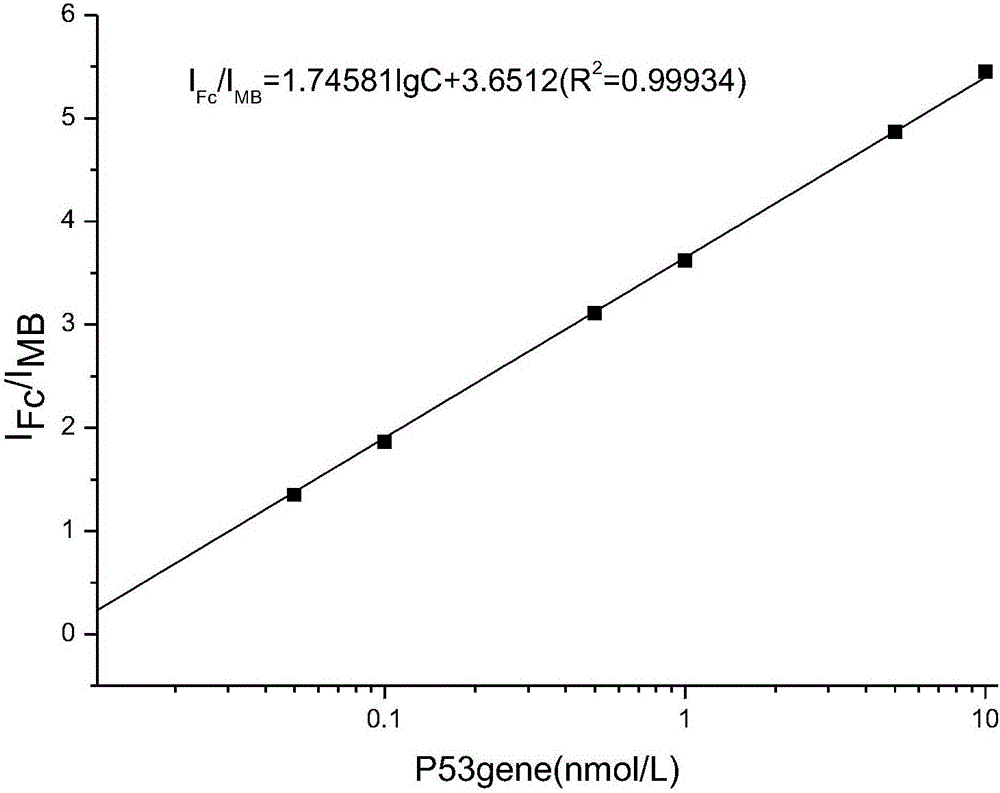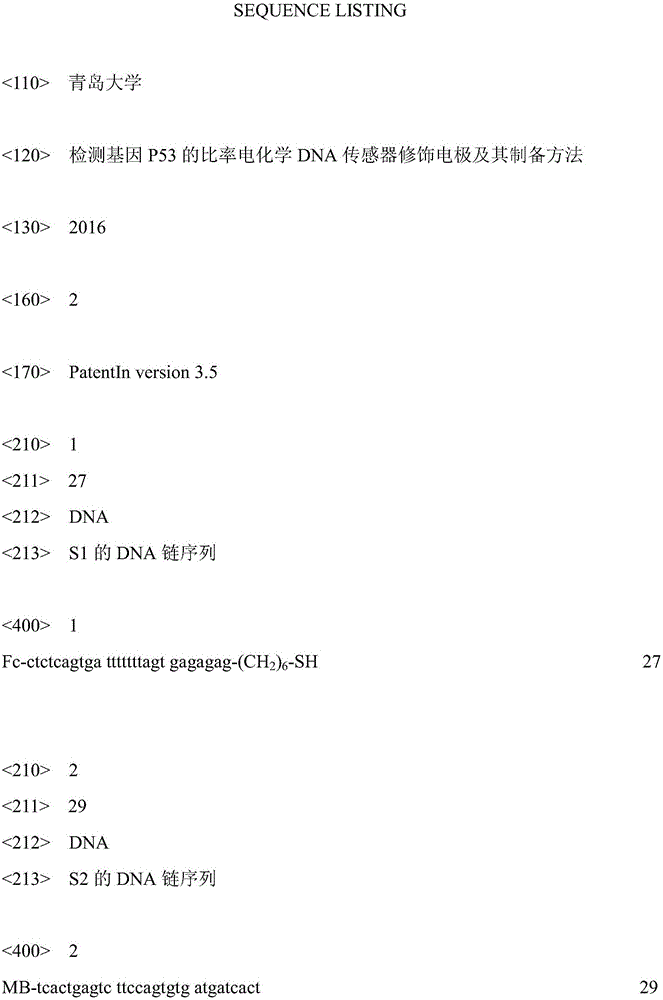Ratio electrochemical DNA sensor-modified electrode for detecting gene P53 and preparation method of modified electrode
A technology for modifying electrodes and DNA strands, applied in the field of electrochemical detection, can solve the problems of high equipment investment, limited clinical application, complicated operation, etc., and achieve the effects of low cost of use, convenient operation, and simple reaction conditions
- Summary
- Abstract
- Description
- Claims
- Application Information
AI Technical Summary
Problems solved by technology
Method used
Image
Examples
Embodiment 1
[0041] A preparation method for the modified electrode of the P53 gene based on the double hairpin structure, such as figure 1 shown, including the following steps:
[0042] (1) Design a single-stranded DNA auxiliary probe S1, the bases at both ends of the DNA chain can be complementary to the bases at both ends of the capture probe chain S2 and have a complementary paired sequence of 10 bases in length, which can be fixed on A hairpin structure is formed behind the surface of the gold electrode; the 5' end of the S1 chain is modified with a ferrocene label, which can generate electrochemical signals; the 53' end of the S1 chain is thiolated so that S1 can be modified by a gold-sulfur bond to the surface of the gold electrode; the DNA strand sequence of the auxiliary probe S1 is: 5'-Fc-CTCTCA GTG ATT TTT TTA GTG AGA GAG-(CH 2 ) 6 -SH-3';
[0043] (2) Design a single-stranded DNA capture probe S2, the bases in the middle part of the DNA chain can be complementary paired with...
Embodiment 2
[0049] A preparation method for the modified electrode of the P53 gene based on the double hairpin structure, such as figure 1 shown, including the following steps:
[0050] (1) Design a single-stranded DNA auxiliary probe S1, the bases at both ends of the DNA chain can be complementary to the bases at both ends of the capture probe chain S2 and have a complementary paired sequence of 10 bases in length, which can be fixed on A hairpin structure is formed on the surface of the gold electrode; the 5' end of the S1 chain is modified with a ferrocene label, which can generate electrochemical signals; the 53' end of the S1 chain is thiolated, so that S1 is modified to the Gold electrode surface; wherein, the DNA strand sequence of the auxiliary probe S1 is: 5'-Fc-CTCTCA GTG ATT TTT TTA GTG AGA GAG-(CH 2 ) 6 -SH-3';
[0051] (2) Design a single-stranded DNA capture probe S2, the bases in the middle part of the DNA chain can be complementary paired with the P53 gene; at the same ...
Embodiment 3
[0057] The application of the modified electrode prepared in Example 1 in detecting the P53 gene, the steps are as follows:
[0058] Soak the modified electrode of Example 1 in Tris-HCl buffer solution, the Tris-HCl buffer solution is a mixture containing 110-150mM Tris-HCl, 100-120mM NaCl, 1-10mM MgCl, its pH is 7.4, water bath Heat for 15 minutes. Then form a three-electrode system with a calomel reference electrode and a platinum wire contrast electrode, and perform DPV detection in Tris-HCl buffer solution to obtain the peak current I of methylene blue 0(MB) , the peak current of ferrocene is I 0(Fc) , repeated several times to take the average value.
[0059] Configure a series of p53 gene buffer solutions, in which the concentration and pH value of the buffer solution are kept constant, and the concentration of p53 gene is adjusted to 10 -8 , 5×10 -9 , 10 -9 , 5×10 -10 , 10 -10 , 5×10 -11 , 10 -11 , 10 -12 M, then soak the obtained electrode in the buffer solut...
PUM
 Login to View More
Login to View More Abstract
Description
Claims
Application Information
 Login to View More
Login to View More - R&D
- Intellectual Property
- Life Sciences
- Materials
- Tech Scout
- Unparalleled Data Quality
- Higher Quality Content
- 60% Fewer Hallucinations
Browse by: Latest US Patents, China's latest patents, Technical Efficacy Thesaurus, Application Domain, Technology Topic, Popular Technical Reports.
© 2025 PatSnap. All rights reserved.Legal|Privacy policy|Modern Slavery Act Transparency Statement|Sitemap|About US| Contact US: help@patsnap.com



